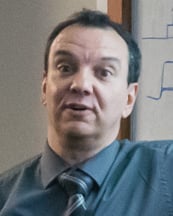Aunt Minnie Article
Date Posted: viernes, diciembre 16, 2016 |
|
Gregory DiGirolamo, PhD's, presentation at RSNA was featured in a recent article in Aunt Minnie. The talk on Thursday, December 1 was titled: In this scientific presentation, researchers will describe how radiologists' performance could be improved by tapping into their unconscious brain processes. |
Can unconscious brain processes improve imaging reads?
By Erik L. Ridley, AuntMinnie staff writer
http://www.auntminnie.com/index.aspx?Sec=road&sub=ris_2016&pag=dis&itemId=115620
Diagnosis in radiology is a complex and difficult visual search task that involves both conscious and unconscious processes. Detection of an abnormality, however, ultimately relies on conscious recognition by the radiologist, said presenter Gregory DiGirolamo, PhD, from UMass Chan Medical School.
While computer-aided detection (CAD) software has been used to improve radiologists' performance, another -- and potentially even more comprehensive -- strategy is to access the full expertise of radiologists, including their unconscious processes, he said.
"We thought we might be able to tap into the unconscious learning and processes that have occurred in the radiologist's brain during their training and their everyday experience," DiGirolamo said.
In previous work, the researchers showed that even when radiologists were not conscious of an abnormality in an image, they looked longer at a location where an abnormality was present. In this study, the researchers wanted to see if radiologists would show increased physiologic arousal -- as measured by pupil diameter -- when they detected a lesion.
The group found that even when radiologists hadn't consciously detected the lesion or even consciously considered it, they still experienced physiologic arousal when looking at the abnormality.
"Moreover, even if they weren't looking at the lesion or had consciously recognized or considered it, if a lesion was present on the image, the pupil diameter increased, showing that the unconscious processes had detected the lesion," DiGirolamo told AuntMinnie.com.
The brains of radiologists undergo extensive training, and only a portion of those processes are used for conscious processing, he said.
"Radiologists are detecting more abnormalities than they consciously report, and we can use these extensive unconscious brain processes to improve health outcomes," DiGirolamo said.




